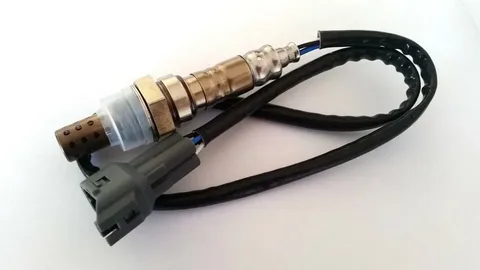The oxygen sensor Suzuki Swift is critical for ensuring optimal engine performance and fuel efficiency. This data helps the ECU adjust the air-fuel mixture for the most efficient combustion, ensuring your vehicle runs smoothly while minimizing harmful emissions. An oxygen sensor that is functioning correctly is essential for keeping the engine running efficiently, passing emissions tests, and maintaining fuel economy. Over time, oxygen sensors can become worn out or dirty, leading to poor engine performance, increased fuel consumption, and even damage to other engine components.
Understanding O2 Sensor Swift
Positioned within the exhaust system of the O2 Sensor Swift, the oxygen sensor measures the oxygen level in the exhaust gases. This data is crucial for the engine control unit (ECU) to fine-tune the air-fuel mixture, ensuring optimal combustion. The sensor generates a voltage signal based on the oxygen content in the exhaust. This signal helps the ECU adjust the fuel injection, thus maintaining the ideal air-fuel ratio.
The effectiveness of this sensor is vital for both engine performance and fuel efficiency. The ECU cannot correctly regulate the air-fuel mixture without accurate readings, leading to potential issues such as increased fuel consumption and harmful emissions. Understanding how this sensor works and its importance in vehicle performance can greatly benefit Suzuki Swift owners who want to keep their cars running efficiently.
Advantages of a Properly Working O2 Sensor Suzuki Swift
The O2 sensor Suzuki Swift is an essential component that contributes significantly to the car’s overall performance, efficiency, and environmental impact. Below are some key advantages of having a properly functioning oxygen sensor:
Optimized Fuel Efficiency
The O2 sensor monitors the air-fuel mixture in the engine and ensures that the ratio is balanced for efficient combustion.
It helps prevent fuel wastage by detecting when the engine runs too rich or lean.
Enhanced Engine Performance
The oxygen sensor supports smooth engine operation by maintaining the ideal air-fuel ratio.
It helps avoid issues such as engine misfires, hesitation, or stalling.
Reduced Harmful Emissions
The oxygen sensor ensures complete combustion, reducing the emission of pollutants such as carbon monoxide (CO) and nitrogen oxides (NOx).
It plays a vital role in meeting emissions regulations, making the Suzuki Swift eco-friendlier.
Improved Longevity of the Catalytic Converter
A properly functioning oxygen sensor prevents unburnt fuel from entering the exhaust system, which could damage the catalytic converter.
This not only extends the lifespan of the catalytic converter but also helps you avoid costly repairs.
Detection of Engine Problems
The O2 sensor provides real-time data to the ECU, allowing early detection of potential engine issues.
Faulty combustion, vacuum leaks, or exhaust problems can often be identified through oxygen sensor readings.
Cost Savings with a Well-Maintained 02 Sensor Suzuki Swift
A properly functioning 02 Sensor Suzuki Swift improves the vehicle’s performance and significantly contributes to cost savings over time. One of the most immediate and noticeable benefits is enhanced fuel efficiency. The oxygen sensor ensures that the engine operates with the optimal air-fuel mixture, preventing fuel waste. When the sensor functions correctly, it prevents the engine from running too rich (excess fuel) or too lean (insufficient fuel), which can increase fuel consumption.
Over weeks, months, or years, fuel expense savings can add up considerably, especially for drivers who frequently commute or undertake long journeys. With fluctuating fuel prices, maximizing efficiency becomes a crucial aspect of cost management for any vehicle owner. Another area of cost savings lies in preventing more severe engine and exhaust system issues. A faulty oxygen sensor can lead to incomplete combustion, causing unburnt fuel to enter the exhaust system.
It increases emissions and places additional stress on the catalytic converter, a critical and expensive component in the exhaust system. Replacing a catalytic converter is significantly costlier than promptly addressing an oxygen sensor issue. By maintaining the oxygen sensor, you can protect the catalytic converter from premature damage, extend its lifespan, and save yourself from unexpected repair bills.
Influence of the Oxygen Sensor on Suzuki Swift Performance
The Suzuki Swift’s O2 sensor plays a critical role in ensuring a smooth and enjoyable driving experience. The sensor provides real-time data to the engine control unit (ECU) by continuously monitoring the oxygen levels in the exhaust gases. This data helps the ECU maintain the perfect air-fuel mixture for efficient combustion. When the air-fuel ratio is balanced, the engine runs seamlessly, reducing common issues such as misfires, hesitation, or stalling.
This consistency translates into a smoother acceleration response, especially during sudden speed changes or while driving through varying terrains. This reliability means Swift drivers will experience fewer hiccups during city commutes or longer highway journeys.
A functioning oxygen sensor also contributes to quieter engine operation. When the engine works with an optimal air-fuel mix, it reduces the strain on internal components, ensuring they operate efficiently without undue wear and tear. It minimises engine noise and prevents vibrations or rough idling, which can be unpleasant during stops or at lower speeds. Whether navigating urban traffic or cruising along open roads, the oxygen sensor helps keep the engine performance steady, offering a more relaxed and comfortable drive.
Indications of a Suzuki Swift Oxygen Sensor Problems
The oxygen (O2) sensor in a Suzuki Swift is a key component for ensuring efficient engine performance and reduced emissions. However, it is not immune to issues that can arise over time. One of the most common problems is sensor contamination. Substances like oil, coolant, or carbon deposits can coat the sensor, impairing its ability to measure oxygen levels accurately. Regular maintenance and timely sensor replacement can help mitigate Suzuki Swift Oxygen Sensor Problems.
This contamination often results from oil leaks or coolant entering the combustion chamber. A contaminated oxygen sensor can send incorrect data to the engine control unit (ECU), leading to an imbalanced air-fuel mixture. The consequences include reduced fuel efficiency, rough idling, and higher emissions, which may trigger the Check Engine light.
Another frequent issue is the oxygen sensor’s natural wear and aging. Like most vehicle components, the sensor has a limited lifespan, typically between 60,000 and 100,000 kilometres. Over time, the sensor’s ability to measure oxygen levels diminishes, causing it to send delayed or inaccurate information to the ECU. This degradation can result in poor engine performance, increased fuel consumption, and difficulties passing emissions tests.
Guidelines for Oxygen Sensor Maintenance
Proper maintenance of your vehicle’s oxygen (O2) sensor, including the Suzuki Swift, is essential for optimal engine performance, fuel efficiency, and reduced emissions. Here are some key guidelines to help you maintain your oxygen sensor and prolong its lifespan:
Adhere to Regular Inspection Schedules
Check the oxygen sensor for routine vehicle maintenance, especially during major servicing.
Include inspections of the sensor’s wiring and connections to ensure they are intact and free from corrosion or damage.
Replace at Recommended Intervals
Most oxygen sensors have a lifespan of 60,000 to 100,000 kilometres. Replace them as per the manufacturer’s recommendations.
Early replacement is advisable if you experience poor fuel economy, rough idling, or a Check Engine light.
Monitor Fuel Quality
Use high-quality fuel to prevent contamination of the oxygen sensor with additives, impurities, or residues.
Avoid fuel with excessive ethanol content, which can contribute to carbon buildup.
Address Engine Issues Promptly
Resolve oil leaks, coolant leaks, or incomplete combustion problems as they arise. These issues can contaminate or damage the oxygen sensor.
Ensure your engine operates efficiently to minimize the risk of unburnt fuel reaching the exhaust system.
Selecting the Appropriate Replacement Sensor
When the time comes to replace the oxygen sensor in your Suzuki Swift, choosing the right replacement is essential. Opt for an original equipment manufacturer (OEM) sensor or an aftermarket option. OEM sensors are typically designed to meet the specific requirements of your vehicle, ensuring compatibility and reliability. However, high-quality aftermarket sensors can also be viable, provided they are compatible with the Suzuki Swift.
Always ensure the sensor you choose is designed for your vehicle model to avoid any performance issues. It’s wise to consult your vehicle’s manual or a professional mechanic to verify compatibility. Additionally, the quality of the materials used in the sensor must be considered. Sensors made from durable materials will likely last longer and provide more accurate readings.
It’s also important to be cautious about extremely cheap options, as these may need to meet the necessary quality standards and could lead to further issues. Ensure the sensor comes with a warranty or guarantee, as this can provide some assurance of its quality and durability. Proper installation is crucial; if you’re not confident installing the sensor correctly, it’s best to seek professional assistance. It ensures the sensor functions as intended, maintaining your Suzuki Swift’s performance and efficiency.
Maintaining the Efficiency and Performance
The oxygen sensor plays a pivotal role in maintaining the efficiency and performance of your Suzuki Swift. Regular maintenance is key; inspect the sensor during routine vehicle checks and replace it as recommended by the manufacturer or when symptoms of malfunction arise. Using high-quality fuel helps prevent contamination and extends the sensor’s lifespan. Ensuring your air and fuel filters are in good condition can also support the sensor’s effectiveness. Avoid fuel additives unless explicitly advised, as they can leave harmful residues.
When selecting a replacement sensor, opt for an OEM or a high-quality aftermarket option compatible with your vehicle. Consult your vehicle’s manual or a professional mechanic for guidance. The right sensor will ensure accurate readings and optimal performance. Beware of overly cheap alternatives, as they may compromise quality and lead to further issues. Always check for a warranty to guarantee durability.
Proper installation of the sensor is crucial. If you’re unsure about installing it, seek professional assistance to ensure it functions correctly. Following these suggestions can enhance fuel efficiency, reduce emissions, and enjoy a smoother driving experience. Keeping your oxygen sensor in top condition ensures your Suzuki Swift delivers reliable performance.
Conclusion
Maintaining the oxygen sensor Suzuki Swift is crucial for keeping your vehicle running smoothly and efficiently. This small but powerful component helps ensure your car operates at its best, optimizing fuel economy, reducing harmful emissions, and enhancing engine performance. A malfunctioning oxygen sensor can lead to various issues, from poor fuel efficiency to costly engine damage. Regular maintenance and timely replacement of a faulty sensor will help you avoid these problems and keep your Suzuki Swift performing at its peak.
FAQS
What Is The Purpose Of The Oxygen Sensor Suzuki Swift?
The sensor monitors the level of oxygen in the exhaust gases and sends this information to the engine control unit (ECU), which adjusts the air-fuel mixture for optimal engine performance, fuel efficiency, and emissions control.
How Do I Know If My Oxygen Sensor Needs Replacing?
Some common signs of a faulty oxygen sensor include poor fuel economy, engine misfires, rough idling, a decrease in engine performance, or the illumination of the Check Engine light on the dashboard.
Can I Drive My Suzuki Swift With A Bad Oxygen Sensor?
While driving with a bad oxygen sensor is possible, it is not recommended. A faulty sensor can cause poor engine performance, increased fuel consumption, and higher emissions, leading to long-term damage and higher repair costs.
| Related Business Listings |
| Contact Directory |
| Local Business Profiles |


